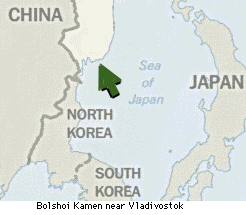| on Russia's rusting nuclear stockpile
|
 Strikes and protests are increasing at both the Komsomolsk na Amur shipyards where submarines are constructed and at the Zvezda shipyard in Bolshoi Kamen near Vladivostok, where the Russian Navy's old nuclear vessels are being decommissioned.
Strikes and protests are increasing at both the Komsomolsk na Amur shipyards where submarines are constructed and at the Zvezda shipyard in Bolshoi Kamen near Vladivostok, where the Russian Navy's old nuclear vessels are being decommissioned.
Both these facilities have potentially dangerous nuclear facilities which need constant monitoring. The situation is further complicated by the overall energy crisis in the region with frequent power cuts to both yards, endangering vital safety equipment.
The risk of a nuclear accident at the Amur Shipyards is increasing daily, with four-fifths of the work force on indefinite strike.
| |
Sobolev says the situation at the company was exacerbated by the fact that in 1993 a nuclear reactor was installed in one of the two submarines still under construction in the yards, and it costs 12 billion rubles ($2.1 million) a month to maintain it.
Because of the desperate financial situation, highly qualified nuclear safety specialists are leaving the company, which currently has 1,500 sources of radiation to monitor.
Protest action is also continuing at Zvezda's nuclear submarine repair yard to demand payment of wage arrears going back to October 1996.
In April, demonstrators sealed off the yards, mounting round the clock pickets around the management building. The protesters threatened to take managing director Vasiliy Maslakov hostage if their demands were not met.
The workers were also objecting to the various private businesses that had set up inside the shipyard and the constant theft of valuable non-ferrous metals. The federal government currently owes Zvezda employees more than 150 billion rubles ($27.2 million) for work to complete state orders for the repair or scrapping of decommissioned submarines.
The developing crisis over the deteriorating condition of decommissioned submarines reached peak on May 30 when a nuclear-powered submarine sank at the Russian Pacific Fleet base in Avachinskaya Bay on the Kamchatka peninsula.
A salvage operation launched on June 2, to recover the vessel from a depth of 20 meters is still under way. The Charley-I class submarine's rusting hull was punctured in a collision with another vessel while it was being moored.
According to a Navy official in Moscow, the reactor's fuel has been removed and Pacific Fleet officials say the remaining reactor section is properly sealed and no radioactivity can leak into the environment. However, the head of the local emergencies committee, Colonel Valery Sukhoborov, says his staff is monitoring the radiation situation on the city side of the bay.
There are 11 submarines of Charley-I class stationed in the Pacific fleet, each one fitted with one PWR type reactor. They were built at the Gorkiy (Nizhny Novgorod) shipyard between 1967 and 1972. In addition, a large number of decommissioned submarines are moored in Kamchatka and Maritime Territory but the Zvezda shipyard in Bolshoi Kamen can process no more than two a year.
Fewer than half the submarines removed from combat duty in the Pacific have had their fuel removed, and only four reactor compartments have been prepared for long-term storage.
Some 60 are awaiting decommissioning moored at the Pavlovsk naval base some 65 kilometers from Vladivostok. Others are moored at a small base in Vladimir Bay some 300 kilometers north east of Vladivostok and at the Zavety Ilyicha base over 900 kilometers to the north east.
Storage of liquid and solid wastes from the dismantled subs also poses a problem as current facilities are inadequate. However, residents of Bolshoi Kamen in June voted against allowing a floating nuclear waste processing plant to be docked nearby.
Some 94 percent of participants in a non-binding poll did not want the plant established anywhere near the town. The official said 13,000 people of Bolshoi Kamen, or 44 percent of eligible voters, took part in the poll.
The floating plant, due to arrive in Bolshoi Kamen later this month, is intended to solve the problem of neutralizing liquid waste from the decommissioned submarines. The waste is now kept at two floating storage tanks outside docks where the submarines are dismantled.
| |
Sea dumping of liquid wastes in the Far East continued into 1993 and officials at the Zvezda Plant warned in mid-1994 that it would have to resume as stores were full. Dumping of low-level liquid wastes into the Sea of Japan in October 1993 caused an international outcry with strong protests lodged by Japan and South Korea. Japan has financed construction of the new processing plant.
Around 5,000 tons of liquid waste are generated each year and makeshift storage facilities at on-shore dumps and in special vessels moored near the coast are full. The shore facilities are in Kamchatka north of the Gornyak shipyard and near Vladivostok at Installation 927-III.
Over 2,000 tons of wastes are stored in various vessels including the TNT-5 (794 tons), the TNT-27 (905 tons), two small PE-50 type tanks (100 tons each) and the most recent addition to the "waste fleet," the 1,000-ton Pinega.
Most of these are moored in the Vladivostok area at various naval facilities. In the opinion of environmentalists at Greenpeace Russia, the Pacific coast is a nuclear accident waiting to happen.
